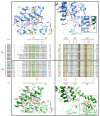Structure-Based Understanding of ABCA3 Variants
- PMID: 34638622
- PMCID: PMC8508924
- DOI: 10.3390/ijms221910282
Structure-Based Understanding of ABCA3 Variants
Abstract
ABCA3 is a crucial protein of pulmonary surfactant biosynthesis, associated with recessive pulmonary disorders such as neonatal respiratory distress and interstitial lung disease. Mutations are mostly private, and accurate interpretation of variants is mandatory for genetic counseling and patient care. We used 3D structure information to complete the set of available bioinformatics tools dedicated to medical decision. Using the experimental structure of human ABCA4, we modeled at atomic resolution the human ABCA3 3D structure including transmembrane domains (TMDs), nucleotide-binding domains (NBDs), and regulatory domains (RDs) in an ATP-bound conformation. We focused and mapped known pathogenic missense variants on this model. We pinpointed amino-acids within the NBDs, the RDs and within the interfaces between the NBDs and TMDs intracellular helices (IHs), which are predicted to play key roles in the structure and/or the function of the ABCA3 transporter. This theoretical study also highlighted the possible impact of ABCA3 variants in the cytosolic part of the protein, such as the well-known p.Glu292Val and p.Arg288Lys variants.
Keywords: 3D modeling; ABCA3; mutation; nucleotide-binding domain (NBD); regulatory domain (RD).
Conflict of interest statement
The authors declare no conflict of interest.
Figures




References
MeSH terms
Substances
LinkOut - more resources
Full Text Sources
Miscellaneous

